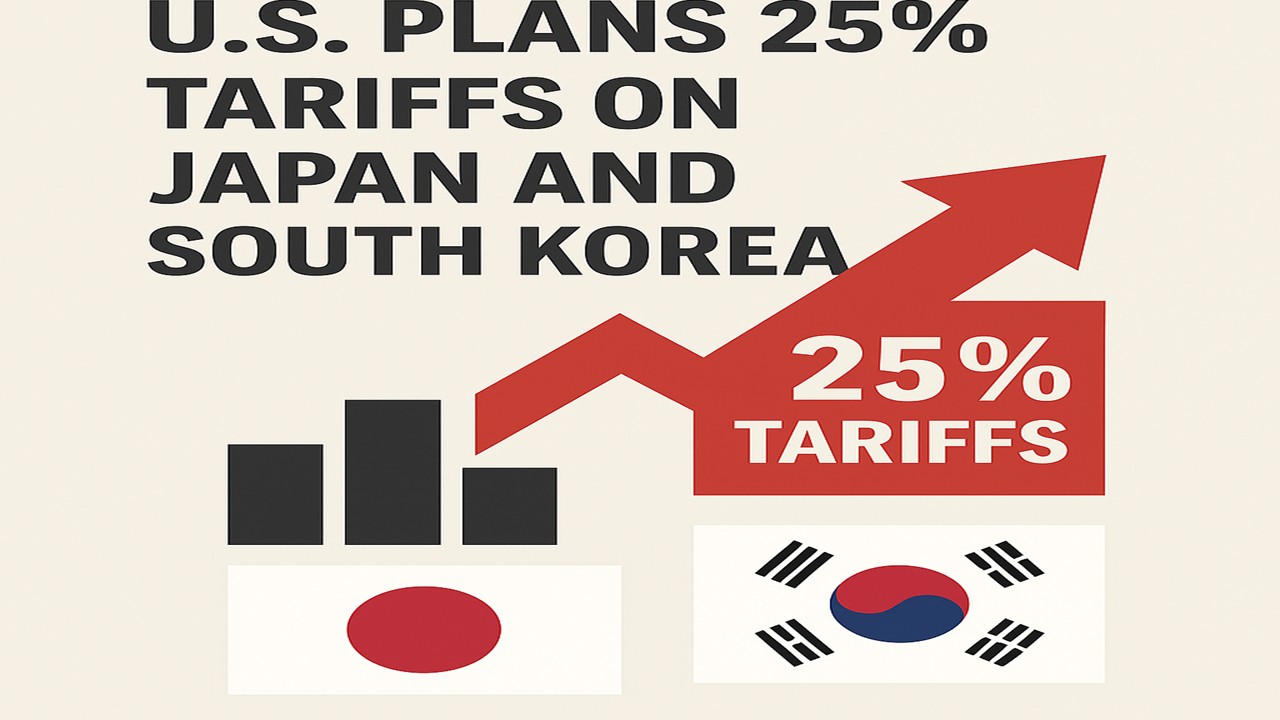
हिंदी में पढ़ने के लिए मेनू बार से हिंदी भाषा चयन करें।
The United States is once again shaking up the global trade scene — and this time, its long-time allies Japan and South Korea are in the spotlight.
According to reports, the U.S. is preparing to impose 25% tariffs on vehicle and auto part imports from both countries. This could lead to a ripple effect across global supply chains, markets, and political relations.
What Will These Tariffs Apply To?
The proposed tariffs mainly target:
- Cars – Automakers like Toyota, Honda (Japan) and Hyundai, Kia (South Korea) would be directly affected.
- Auto Components – Parts like engines, gearboxes, and braking systems that are often assembled in the U.S. using imported material.
Impact on buyers:
Higher import taxes usually mean higher prices for consumers, as companies pass on the cost burden.
Why Is the U.S. Doing This?
The U.S. administration argues:
- American manufacturers are losing ground – Japanese and Korean carmakers are selling more and hurting domestic players.
- “National security” concern – The government says the U.S. must maintain its own vehicle manufacturing in case of emergency.
In short, this move is part of the larger “Make in America” economic strategy.
How Has the World Reacted?
- Japan and South Korea are disappointed and considering pushing back diplomatically.
- Trade analysts warn this could slow down global commerce, disrupt supply chains, and push up prices.
- Even some U.S. industries have opposed the idea, saying it will increase their operational costs.
🇮🇳 What Could It Mean for India?
India is not directly targeted, but it may still feel the impact in several ways:
- Stock market sensitivity – If global markets dip, India’s market could follow.
- Export opportunities – Indian companies could benefit as alternative suppliers of auto parts or raw materials.
- Diplomatic balancing – India may need to carefully manage relations with both the U.S. and East Asian economies.
What Happens Next?
There are three possible outcomes:
- Retaliation – Japan and Korea might respond with their own tariffs.
- Negotiation – All sides could come to the table and resolve the issue.
- WTO intervention – If the matter escalates, the World Trade Organization may be brought in.
🗓️ Timeline Box: How the Tariff Drama Unfolded
| Date | Event |
| Jan 2025 | U.S. starts reviewing trade imbalances in key sectors |
| Mar 2025 | American auto lobby raises concerns about foreign imports |
| Jun 2025 | Internal reports hint at tariff letters being prepared |
| Jul 6, 2025 | U.S. officially sends warning letters to Japan and South Korea |
| Jul 7, 2025 | Both countries express concern and seek WTO guidance |
| Jul 8, 2025 | Global markets react, uncertainty rises |
Impact Table: Who Gets Affected, and How?
| Sector / Country | Likely Impact | Why? |
| Japan | 🚗 Export slowdown | Heavily dependent on U.S. car sales |
| South Korea | 📉 Hyundai/Kia to lose market share | Tariffs may reduce competitiveness |
| U.S. Consumers | 💸 Costlier vehicles | Tariff costs passed to buyers |
| U.S. Automakers | 🏭 Short-term relief | Less competition but higher part costs |
| India | 📈 Opportunity in exports | Could step in as alternative supplier |
| Global Markets | 📉 Volatility | Fears of a trade war or slowdowns |
This isn’t just a tax — it’s a message. The U.S. is telling its allies: “No more free rides in trade.”
But this strategy comes with risks: global retaliation, price hikes, and economic instability. Whether this is a power play or a policy misstep, only time will tell.
For now, the world watches and waits — with fingers crossed and calculators ready.
Sources: Reuters ,Bloomberg ,Business Standard




































































